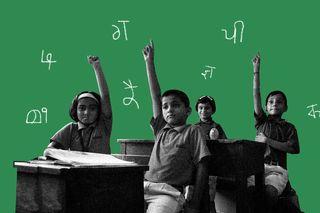
Dissecting the NEP: How the Policy Will Only Widen the Education Gap in India
Certain aspects of NEP’s implementation, in relation to language and caste, will deepen the societal divides in India.

The National Education Policy 2020 (NEP), unveiled by the Union Cabinet on July 28, purports to completely overhaul the Indian education system — right from lower primary to higher education. The plus points of the policy are immediately visible: a move away from rote learning (NEP 4.4, 4.31 and 4.34), an overhaul of the board exams (NEP 4.38), and the flexibility to learn beyond a ‘stream’ of arts, science, or commerce (NEP 4.9). While this is a step forward, other parts of the policy take us several steps back.
The NEP seeks to achieve Goal 4 (SDG4) of the 2030 UN Agenda for Sustainable Development, to ensure inclusive and equitable quality education and promote lifelong learning opportunities for all. However, certain aspects of its implementation, in relation to language and caste, will instead deepen the societal divides in India.
English and the Path to Social Mobility
Indian schools usually teach three languages in the classroom. Under the NEP, this three-language formula will continue “while keeping in mind … the need to promote multilingualism as well as promote national unity” (NEP 4.13). The states and students will be able to choose these languages, with an important condition — two of the languages must be native to India. This condition rules out English from the two compulsory “native” Indian languages, meaning that the third language must either be English or another foreign language at the cost of foregoing English. The policy does not address this confusion.
While the NEP assures us that efforts will be taken to ensure that students will be able to speak in their mother tongue as well as in English (NEP 4.14), the subversion of English makes the fate of the language — and those who rely on it for social mobility — uncertain.
English is an aspirational language for Indians. It is an instrument of social mobility for marginalized communities. Sankul Sonawane, a 17-year-old student from Pune, summarizes this point in a piece for Akademi Mag: “Relatives would often remark how fortunate I was to have had the opportunity to study at an English school. Friends from my neighborhood would ask me what it was like to study in a ‘rich’ school. I am aware of the privileges that come with being proficient in English. It allows me to be confident about myself and assert my identity. It lets me question my professors and interact with my socially privileged classmates. It gives me respect and admiration in public because speaking in English is a mark of being ‘educated’ in India.”
Related on The Swaddle:
How Learning Differs Across India’s Education Boards
Sonawane reflects on what English does for people who learn it at school: it provides a push forward. This push forward has already been quantified, and the results are significant: Hourly wages are 34% higher for men who speak fluent English and 13% higher for men who speak a little English relative to men who speak no English. Further, the paper estimated the benefits of being fluent in English as being half as large as the benefits of completing a bachelor’s degree.
In the context of the NEP, those who already speak English at home — most likely the upper-caste children — will not face the brunt of these changes. But children who learn English at school and who would not normally have access to English at home or amongst peers will be the most impacted. They will lose out on social mobility, higher education opportunities, jobs, and therefore the chance to improve their lives. The move will adversely affect the disadvantaged castes and classes whose children and children’s families survive when they learn (and learn in) English.
What is a Mother Tongue?
Next, the NEP recommends that the medium of instruction in schools till Grade 5, and preferably till Grade 8, be the “home language/mother tongue/local language/regional language” (NEP 4.11). Higher education institutions are also encouraged to use local languages as a medium of instruction (NEP 22.10). The aim is to promote cultural enrichment and national integration (NEP 4.15).
It is unclear how this will translate for each region or state, in which people speak, read, and write in several languages, unhindered by geographical region. What do we mean by mother tongue? A state may have several linguistic identities, and to choose one over the other as a medium of instruction is arbitrary and exclusionary.
Another distinct issue is that this recommendation does not account for children who migrate from one part of India to another. While earlier, children could easily transition between schools with English as the language of instruction, they will now struggle to adapt to new mediums of learning. It is almost hypocritical that the policy encourages national integration by focusing on regional identity through language.
The recommendation is also at odds with state efforts, such as the Andhra Pradesh government’s decision to use English as the language of instruction in government schools. The decision, announced in late 2019, was seen as a move to reduce inequality and promote social mobility.
Caste and the Illusion of Merit
Besides a few stray, mandatory mentions of Scheduled Castes, Scheduled Tribes, and OBCs, the NEP does not touch upon caste-based oppression in education. The primary issue here is the lack of any mention of reservation. Instead, the policy tucks the issue gently between the small offerings of scholarships and assistance to the “meritorious” underprivileged (NEP 6.16). Any education policy must contain a clear acknowledgment that there is a gap between the starting line for the elite and the marginalized.
A more nuanced understanding of privilege and deprivation reveals that there is no such thing as pure merit. Reservation does what financial assistance cannot — it provides a leg up. The privileged classes use their social capital and money to climb ladders, while the underprivileged have no such thing. Education is the first step toward upward mobility. If we do not concentrate on giving a leg up to caste and class minorities in school, they will remain on the lowest rung of the ladder through education and employment for generations. It is our constitutional responsibility, as a system, as an organization, to include those who are excluded. The NEP’s silence on reservation is therefore deafening.
Related on The Swaddle:
How the Indian Education System Reinforces Caste, Class Differences
With higher education, it is the institute that is encouraged to offer freeships to students (NEP 12.10) instead of the government providing any affirmative action. The policy transfers the burden of bringing and keeping underserved children within the education system to private institutions, places that often view education as a business to be sustained by those who benefit from it. This deepens the divide between the privileged and the deprived sections of society, for whom attending a private or foreign university will never be a reality without serious checks on its functioning. Here also, the NEP moves away from its object of equitable education.
Further, the NEP welcomes foreign universities to set up their campuses in India. These universities will be regulated at par with autonomous institutions (NEP 12.8), which again leads to some of the same concerns as above. The impetus to the privatization of education means the ability of these autonomous institutions– foreign or Indian — to raise fees and choose their own admission criteria. Autonomy also means that equity, quality and access are not insisted upon, which clouds the welfare lens through which we must view education.
Taking a few steps back
These are only a few of the pain points of the NEP. Others are its hazy implementation and the focus on releasing a new education policy in the midst of a pandemic, while not adequately accounting for changes we will have to make to adapt the existing education system to a more restricted life.
If we are to reimagine our education and make it just and accessible, we must first integrate those excluded from the system. To do so, we would have to work on slowly recasting the systems that oppress and marginalize our own communities, instead of implementing policies that will further cement them firmly in place.
The author would like to thank Shruti Venkatesh, Program Director, Gender Justice at One Future Collective, for her input.
Sanaya Patel is a dispute resolution lawyer in Bombay. She is the Chief Legal Officer at One Future Collective, a nonprofit nurturing radical kindness in people, communities and organizations -- with a vision of a world built on social justice, led by communities of care. She is the co-author of Partitioning Histories, a publication which juxtaposes Indian and Pakistani textbook narratives on pre-Partition history. She is interested in gender justice, music, and making the law accessible to everyone.
Related


4,000+ Students Observe Hunger Strike to Protest JEE, NEET Exam Dates
